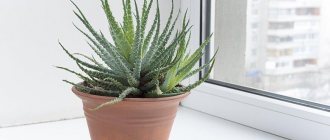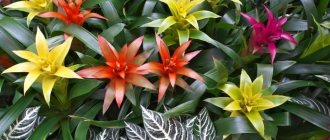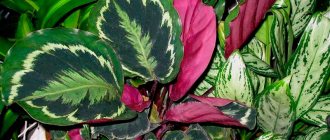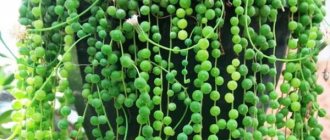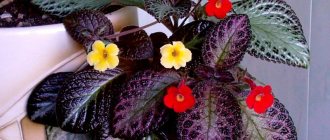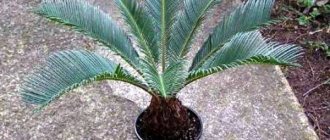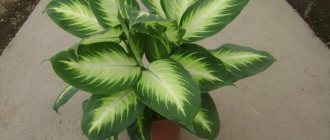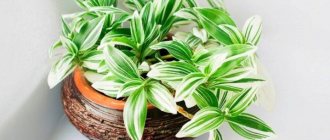Is it possible to keep peperomia in the house: types of plants and signs associated with it
Most of us choose our indoor plants for their flowering or chic decorative appearance. However, there are also flower growers who listen to folk signs and would never buy a flower that, according to superstition, brings trouble. Take peperomia, for example – a gorgeous plant with beautiful leaves. Is it possible to keep peperomia at home, what kind of culture is it, and what signs are associated with it?
How to water
- Watering. Peperomia obtufolia is watered rarely - once every ten days. Moderate watering, especially in spring and summer. Before the next watering, be sure to check that the earthen lump in the pot is dry. We water with warm water. When watering, protect the leaves from drops of moisture. The winter season is a time of rest, so we reduce watering to a minimum. We wait for the earthen lump to dry out. When watering, do not allow the soil to become too waterlogged. We water small-leaved and low-growing peperomia constantly and moderately, with the exception of the winter season - we water with a minimum amount of water. The watering process must be carried out carefully, avoiding stagnation of moisture and drying out of the soil.
- Feeding. We feed peperomia once a month. We fertilize during the period of active growth and development of the plant. This is the period from March to August. We apply fertilizers every two weeks. It is better to use liquid mineral fertilizers, which are added to water for irrigation. The dosage of fertilizer should be reduced by half than in the instructions. In other words, we reduce it by half. The need for fertilizing can be determined by the young leaves; if they begin to become smaller, then this is a sign that there is not enough nutrition.
When buying a plant, choose a healthy plant. It should not show signs of mechanical damage or damage by pests or various diseases.
What is peperomia?
Peperomia obtufolia is most often sold as a houseplant. It belongs to the pepper family and grows as a compact bush, the height of which does not exceed 25 cm. At a young age, its shoots are erect, but droop over time. The main advantage of the plant is its leaves: large, dense, fleshy. They are round in shape, rich green and covered with a glossy sheen. With good care in the spring, the bush produces a peduncle, like a plantain, but it is not particularly decorative. However, this is far from the only type of crop and there are even more colorful plants. They can be bushy or ampelous, variegated, low-growing, and even with original wrinkled leaves. Of the other varieties of peperomia (and there are more than 1000 of them), the following are found at home:
- Of the ampelous species with long hanging shoots: climbing peperomia, creeping peperomia, perestromyia.
- Bush forms with short branches or dense foliage rosette: wrinkled peperomia; watermelon; Magnolifolia.
- Low-growing and unpretentious succulent peperomia: Ferreira, Graveolens, oblong.
Secrets of plant care
Caring for Peperomia obtufolia at home is not difficult, since the plant is very unpretentious. It will feel good if conditions are created that are close to natural .
Lighting. Peperomia loves bright but diffused light. In direct sunlight, the foliage withers and looks lifeless. A lack of lighting will also negatively affect the decorative appearance of the plant. Therefore, it is best to place flower pots on an eastern or western windowsill. If the plant is located on the south side, the window should be covered with light curtains; on the north side, additional lighting should be provided.- Watering. The flower needs abundant regular watering. In hot periods, the plant is watered once every seven days, in cold weather - twice a month. Do not allow moisture to stagnate in the pot, as this will lead to rotting of the root ball. For irrigation, settled water at room temperature is used. In summer, the plant can be sprayed with a spray bottle or bathed in a warm shower.
- Temperature. Peperomia is a heat-loving plant. The optimal temperature will be twenty to twenty-five degrees Celsius. In winter, temperatures can drop to sixteen degrees. Sudden changes should be avoided, otherwise the plant may shed its leaves.
- Landing. For peperomia, shallow, wide pots made of clay, ceramics or plastic are suitable. As soil, you can use either a ready-made soil mixture for ornamental plants, or prepare it yourself by mixing leaf humus, peat and river sand in a 2:1:1 ratio. For drainage, pour a five-centimeter layer of fine gravel, pebbles or broken bricks.
- Transfer. A young plant needs to be replanted once a year, an older one - once every three years. For transplantation, select a pot approximately one and a half times larger than the previous one. A drainage layer and ten centimeters of soil are poured onto the bottom. Peperomia must be carefully removed from the old pot and, together with the soil remaining on the roots, placed in a new pot. Sprinkle soil on top, compact it and pour warm water over it. Place the pot in a shaded place for several days, then place it on the selected windowsill and care for it as usual.
- Trimming. Peperomia shoots are cut off when their length exceeds twenty centimeters. The branches are cut approximately four centimeters from the ground level. There should be at least three leaves left on the shoot. Soon several new side shoots will appear at the cut site.
- Fertilizers. To feed peperomia, ready-made mineral fertilizers are suitable, which are used to feed decorative indoor flowers. During active growth, fertilizers are applied twice a month, during dormancy - once during the same period.
These are all the basic rules for caring for Peperomia obtufolia. Compliance with them will allow you to grow a healthy and strong flower.
Is it possible to keep peperomia at home: folk signs about the flower
It is immediately worth noting the beneficial properties of the plant. While wiping the fleshy leaves from dust, did you notice an interesting aroma? This smell will help relieve headaches. Peperomia also cleanses the air in the house from toxins and destroys pathogenic microbes. It is not surprising that the plant is recommended to be placed in the room of those who have recently suffered from an illness. It helps the body recover faster.
Peperomia leaves are endowed with one more property (already from the realm of the supernatural). They absorb negative energy, transform it into positive energy, and generously give it to their owners. Moreover, varieties with round or oval leaves, as well as those with a pointed leaf blade, are endowed with such abilities.
Peperomia is popularly called the “flower of love” for its benevolent nature.
And the teachings of Feng Shui endow it with only positive qualities. So, cute bushes:
- help to improve relationships, avoiding scandals and quarrels;
- make household members more tolerant and gentle towards each other;
- stimulate decision-making and change of life situation.
Thus, there is no doubt that peperomia is an ideal plant for the home, especially for the family. She will bring only joy, love and peace to personal relationships.
Indoor variety of the plant Peperomia "Tupolist"
Peperomia bluntifolia is a low-growing evergreen plant from the pepper family, which migrated to apartments and houses from the tropical forests of South America.
Florists distinguish several indoor varieties of this flower, which differ in their coloring characteristics.
Among the most popular forms of Peperomia obtufolia are Alba with monochromatic light leaf blades, Variegata with irregular cream-colored spots and Albomarginata with a silver border framing the gray-green middle of the leaf.
You can visually familiarize yourself with Peperomia “Tupolist” in the photo below:
Home care
Care after purchase
When buying a plant in a store, pay attention to its appearance.
After purchase, it is recommended to transplant the plant into another pot within a week.
Trimming
When performing this operation, the cut line is made at a height of 3–4 cm from the ground level , leaving 3 bottom sheets. At the same time, 3-4 young lateral shoots will begin to grow from the remaining stump, which can be rooted if desired.
Common methods of propagation of Peperomia obtufolia
Seeds can occasionally be found on sale. They are sown on the surface of the soil, sprayed generously with water and covered with transparent film or glass for a greenhouse effect. If the seed is fresh, seedlings will appear within 2 weeks. The ideal time for sowing is April.
But it is much easier to get a young bush from a cut shoot. To do this, take a freshly cut twig with 3-4 leaves and immediately stick it into a pot with moist soil, deepening it by 2-3 cm. Subsequently, the soil is regularly moistened.
Note! Rooting takes no more than 1-2 weeks.
In rare cases, individual leaves may be used for propagation. A leaf with a petiole, just carefully cut, will do. It is left to dry for 1-2 hours and then stuck into the ground. It is recommended to cover the top with a glass jar. This rooting occurs more slowly, but generally takes no more than 3 weeks. An unsuccessful result can be seen immediately - the leaf will simply wither.
Beneficial features
Aesthetic
The plant is valued for its beautiful greenish leaves, which, depending on its decorative form, endow the grower with various color nuances in the form of silver or golden stripes, cream spots or light intricate strokes.
Harmonization of the surrounding space
There is an opinion that peperomia normalizes the energy of the living space, puts you in a positive mood, smooths out quarrels, lifts your spirits, gives peace of mind and good sleep .
Disinfectant
Due to the fact that the plant secretes phytoncides , it purifies the air from various pathogens . Therefore, it is useful to place the flower in the rooms of people who often suffer from colds.
Medicinal
As a representative of the zodiac sign Cancer, Peperomia obtufolia has a beneficial effect on the functional state of the gastrointestinal tract, gall bladder and mammary glands.
The plant is safe for people and does not produce poisonous sap or toxins.
Diseases and pests
Spider mite
Favorable conditions for the development of the parasite appear when the air is very dry.
A white cobweb is noticeable on the stems of the plant, the leaf plastics dry out and fall off. To combat spider mites, wipe the flower with a damp soft sponge and regularly spray it with warm water.
If these measures are ineffective, insecticides are used, for example, a 0.15% Actellik solution (1–2 ml per 1 liter of water).
Thrips
This pest settles in large colonies on the underside of the leaf, with light spots appearing on its upper part. Subsequently, the leaf blade acquires a gray-brown color with a silvery tint.
The only treatment method is the use of insecticides: “Aktellika”, “Fitoverma” and “Inta-vira”.
Mealybug
Control methods involve collecting insects by hand and wiping the base and leaves of the flower with a sponge soaked in alcohol .
Root collar rot
Transplanting the plant into a new pot and reducing the amount of watering will help correct the situation .
What does Peperomia obtufolia look like?
Peperomia is a low herbaceous plant from the Pepper family. In nature, this flower lives in Central and South America, as well as in parts of Brazil and Ecuador.
The height of the plant, as a rule, does not exceed 40 cm. The structure of the shoots is thick, the leaves are round, 8 cm in diameter, dense, green, covered with an inconspicuous film. They are attached to the stem using petioles. The peduncles are spike-shaped, similar in shape to the peduncles of plantain.
Pereromia blooms almost imperceptibly, since its flowers are very small and inconspicuous.
The plant is mainly used as a hanging plant and grown on windows or balconies; it also looks good in hanging flowerpots.
There are several varieties of Peperomia obtufolia, their main differences being the color (solid dark green or variegated) and the shape of the leaves (oval, lanceolate).
Types of peperomia with photos and names
Velvety peperomia (Peperomia velutina)
This species comes from Ecuador and is represented by herbaceous perennial plants. The dark red, straight, pubescent stem is located vertically. The length of the petioles of the leaf blades is about 10 mm. The alternate rounded leaves are green. On the front surface of the leaf blade there are 5–7 greenish veins from the base to the top. In different varieties, the foliage can be either glossy or covered with short hairs. During flowering, spikelet flowers grow on the tops of branches or from leaf axils, the length of which is about 70 mm.
Peperomia clusiifolia
In nature, this perennial herbaceous plant is found in the tropical forests of Venezuela. Dense sessile petiolate alternately arranged leaf plates have a dark green color with a slight reddish tint. The leaves are about 15 centimeters long and up to 8 centimeters wide, their edges are purple, the base is wedge-shaped, and the upper part is most often blunt.
There is a variety of variegata, its leaf blades are not very dense and have a variegated color. The edge of the plate is pale red, closer to the middle the leaf becomes yellow, and near the vein it is dark green. This species does not occur in natural conditions.
Reddish Peperomia (Peperomia rubella)
This species is a herbaceous perennial branched plant with thin red stems. Small oval-elongated foliage on the stem is arranged in fours opposite each other, its front surface is green and its back surface is red. The species is highly decorative.
Peperomia maculosa
This plant comes from the mountain forests of tropical latitudes of South America. The species is represented by herbaceous perennial plants. There are many brown spots on the surface of the green stems. Glossy, long, ovoid leaf blades grow from the root, are about 20 centimeters long, and are colored dark green with white veins. Long inflorescences are brown in color.
Peperomia marmorata
In nature, the species is found in Brazil; it is represented by a low herbaceous perennial plant that forms a lush bush. The round, heart-shaped green leaf blades are decorated with pale brown veins that extend from the base of the leaf and are directed towards its upper part.
Creeping Peperomia (Peperomia serpens)
This epiphytic perennial plant comes from the swampy forests of the tropical latitudes of the American continent. Its stems are vertical, hanging or recumbent. The shape of the petiole leaf plate is flattened-ovate, with a heart-shaped notch at its base. The color of alternate foliage can be variegated or green. The species is cultivated as an ampelous plant.
Peperomia blanda
In nature, the species is found in South American tropical forests. It is represented by epiphytic perennials. The stems are densely covered with hairs. Small oval leaf plates are arranged oppositely on the stems in 3 or 4 pieces, their width is about 15 mm, and their length is up to 40 mm. The back surface of the plate is red, and the front surface is green.
Gray Peperomia (Peperomia incana)
In nature, the species is found in Brazil. It is represented by herbaceous perennial plants or subshrubs, the height of which is about half a meter. The stems are densely covered with hairs. Dense green leaf plates taper slightly towards the top and have a rounded shape, they reach up to 50 mm in diameter, the surface is covered with white hairs.
Silver Peperomia (Peperomia argyreia)
In nature, the species is found in Brazil and Venezuela. It is represented by terrestrial perennial or stemless epiphytic plants. The petioles of the foliage reach about 100 mm in length, they grow from the root and are colored red. The bare, fleshy and dense leaf plates have 7–9 green veins, between which there are whitish stripes.
Peperomia caperata
This species is native to Brazil. The height of the bush is only about 10 centimeters. Petiolate leaf plates, like rosettes, grow from the root. Their ribbed petioles are pinkish in color. The plate is covered with many veins, which are strongly convex on the back surface and concave on the front surface. The foliage color is green and the veins are brown. During flowering, which occurs in summer, white spikelets grow. This species is grown both as a flowering plant and as an ornamental foliage plant.
Peperomia obtusifolia
In nature, the species is found in the tropical latitudes of South America. This herbaceous perennial can grow both on trees and on the ground. There is pubescence on the surface of the stems. Dense, fleshy, petiolate, alternately arranged leaf plates are dark green in color and have an ovoid shape (expanding towards the top of the leaf and narrowing towards the base). The length of the foliage is about 8–12 centimeters, and the width is up to 4–5 centimeters. Flower growers cultivate many varieties and forms.
PARTNER NEWS
Beneficial properties and harm
- Peperomia obtufolia is known primarily for its beneficial properties:
- aesthetic - this is a small ornamental plant with bright foliage of unique colors;
- disinfectants - cleans the air in the room from fungi and microorganisms due to the release of phytoncides;
- medicinal - improves the functionality of the stomach and intestines, urinary system and mammary glands.
The flower has no harmful properties and does not pose a danger to humans, since it does not contain any poisons or toxins.
However, Peperomia obtufolia is also accompanied by some superstitions and folk signs. Some of them are probably related to the healing properties of the plant.
- If there is peperomia in the house, love and prosperity will reign in the family.
- By growing this flower, you will protect yourself from quarrels and have enough money.
- It should not be accepted as a gift, as it will bring grief to the family. But if you buy the flower with a coin, misfortune can be avoided.
- If you grow peperomia at home, family members will rarely get sick.
- In the house where this flower grows, loyalty will remain, all family members will be close to each other.
- Being in the same room with a plant, a sick person recovers faster.
- By placing peperomia in the bedroom, you can get a good, healthy sleep.
Conditions for growing at home
Growing peperomia does not require any special effort. Compliance with basic maintenance requirements will help maintain the attractive appearance of this plant. Let's take a closer look at how to properly care for it at home.
Lighting and ventilation
Peperomia needs moderate lighting, so it is best to place it in the northwestern or eastern part of the room. But in winter, the flower, on the contrary, needs stronger lighting, otherwise the leaves will lose color or even fall off.
The plant does not tolerate drafts and temperature changes well, so if you plan to ventilate the room in which the flowerpot is located, you need to move the peperomia to another room in advance.
Air temperature and humidity
Comfortable temperature for growing peperomia is +20…+24 °C. Heat of +30 °C and above is difficult for the plant to tolerate. In winter, the temperature can be reduced to +17...+18 °C, and if you reduce watering, the plant will be able to withstand temperatures up to +10 °C. If you need to increase or decrease the temperature in the room where the flower is kept, you should not do it suddenly.
The flower requires frequent spraying if it is in a room with low humidity. The optimal humidity level for this plant should be 60–70%.
Home care
Caring for peperomia at home is not difficult, since it is a fairly unpretentious plant. The main thing in growing a flower is to follow the regimes of moistening, feeding and replanting.
Watering
The plant should be watered with soft water at +2…+3 °C above the ambient temperature. In summer, the flower should be watered once every 2 weeks, in winter - once every 3 weeks. You also need to ensure that the soil in the pot does not dry out.
Watering should be carried out directly under the root, and the remaining water in the pan should be drained so that it does not stagnate and bacteria do not grow in it, which can damage the root system of the flower.
Top dressing
Peperomia needs to be fertilized once every 2 weeks, from spring to the end of summer (March - August). In the cold season, fertilizing is carried out once a month.
For feeding, you can use a universal liquid fertilizer for indoor plants. It should be applied after watering to moist soil. If you add fertilizer to dry soil, you can burn the root system of the peperomia. Considering that the roots of this flower are delicate and small, improper feeding can destroy the plant.
Brief description of cultivation
- Bloom. Peperomia is cultivated as an ornamental foliage plant.
- Illumination. Needs a lot of bright diffused light. Variegated forms are more demanding on lighting compared to green-leaved forms.
- Temperature conditions. In the spring-summer period - up to 22 degrees, and in winter - about 17-18 degrees.
- Watering. During the growing season, watering should be plentiful. In cold weather, watering is scarce and infrequent, but the clod of earth in the pot should not be allowed to dry out.
- Air humidity. The flower grows well at air humidity typical for residential premises. However, on hot summer days the bush needs to be moistened with a spray bottle in the morning or evening.
- Fertilizer. Fertilizing is carried out twice a month in the spring-summer period; for this purpose, a mineral complex fertilizer for decorative deciduous plants is used.
- Rest period. Not clearly expressed.
- Transfer. Until the plant is 3 years old, it needs to be replanted regularly every year. Older bushes are subjected to this procedure once every 2 years.
- Soil mixture. Its composition should include sand, peat, humus and leaf soil.
- Harmful insects. Spider mites, thrips, scale insects, mealybugs and nematodes.
- Diseases. With improper care or in unsuitable conditions, the plant’s stem may rot, the foliage may fall off, or it may lose its decorative effect.
Reproduction
There are 3 ways to propagate Peperomia dullifolia:
Many gardeners use cuttings for propagation, since this method does not require much effort and time. Dividing a bush is also a simple process in which you can get a new flower. But propagation using seeds is more difficult, since it is quite difficult to obtain seeds from this plant due to the fact that they are very small.
Cuttings
Propagation by cuttings is carried out during the period of pruning shoots. A suitable stem should have several leaves and a couple of internodes. The cuttings should be rooted in a mixture consisting of peat and sand, the ratio of which is 2:1. The shoots need to be buried 3 cm into the soil mixture.
After planting, you need to set the room temperature at +18...+22 °C. It is also necessary to maintain high humidity to speed up the rooting process. Roots may appear in 2–5 weeks, depending on growing conditions. After this, the shoots should be planted in pots with a diameter of 7 cm.
Dividing the bush
It is best to propagate peperomia by dividing bushes in March-April, when an adult plant is transplanted. With this method of propagation, it is necessary to manually or using a blade divide the peperomia rhizome and plant the resulting bushes in separate pots.
The soil for planting should be loose, low acidity, and consist of humus, sand, peat and leaf soil in a ratio of 1:1:1:3.
After this, as usual, once every 2-3 years you need to replant the plant in new soil.
Using seeds
Sowing of seeds is also carried out in March-April. The sowing mixture must be made from sand and leaf soil in a ratio of 1:2. After sowing, the container with the seeds should be covered with glass, and it is important to ventilate the sprouts 2 times a day.
After the second leaf appears, the seedlings need to be planted in boxes or pots. The soil used is the same as for sowing. The distance between sprouts should be 2 cm.
After 2–3 weeks, the seedlings can be transplanted into containers with a diameter of 7 cm. The soil for replanting should consist of peat, sand, turf soil and leaf soil in a ratio of 2:1:2:2.
How does it reproduce?
- Peperomia obtufolia reproduces at home by stem shoots and leaves. You can divide an adult bush. The procedure is best performed in the spring.
- The seedlings take root in small special cups, then they are transplanted into small pots to grow.
- You can simply root cuttings in damp sand; you can use a mixture: coarse sand, peat, leaf soil in equal proportions. Drainage is required.
Seeds
Growing seedlings by sowing seeds at home is problematic. The seeds are small, you need to correctly determine the time of their ripening, have time to collect them in time, and dry them under certain conditions. Immediately before sowing, the seeds should be soaked in a manganese solution.
Seed planting scheme:
Drainage is poured into a wide container, then a layer of substrate.- Seeds are distributed over the surface.
- The containers are covered with film or glass.
- The greenhouse is ventilated 2 times. in a day.
- Air temperature – 24°C.
- Regular moistening through shallow irrigation of crops.
- When leaves appear, the seedlings are planted in separate boxes.
- The distance between sprouts is 2 – 2.5 cm.
- After 3 - 4 weeks, the seedlings are transferred to separate pots using the transfer method.
Leaf cuttings
After spring pruning, the stems are used for cuttings. Each cutting should have 2 leaves and nodes. You can take cuttings from the stems in the fall. The process is not labor-intensive, the plant takes root easily and quickly takes root. Before rooting, the stem should be treated with root.
The procedure for rooting cuttings:
- You can root in water at a temperature of 22 – 25 °C.
- You can use containers with wet substrate.
- Rooting cuttings requires a bright, warm place and regular moisture.
- After 3 weeks, when the roots appear, the cuttings are planted in separate small pots.
Reference! To maintain the required humidity, the seedlings are initially covered with film, and the greenhouse is regularly ventilated. Peperomia obtufolia leaves take root using the same pattern. Leaves for propagation are selected dense, large, without damage.
Dividing the bush
Only an adult, well-grown bush with many side shoots divides. The time of division is the beginning of spring.
Division procedure:
- The entire bush is carefully removed.
- Dry and rotten roots are cut off.
- The bush is divided into 2-3 parts.
- Each should have healthy roots and stems with nodes and leaves.
- Each part is moved into separate pots.
- There is a layer of drainage at the bottom of the pot; the voids are filled with the prepared mixture.
- Plants are watered regularly.
- The pots should be removed to a shaded place.
- Rooting time – up to 4 weeks.
Possible difficulties during cultivation
Although peperomia is blunt-leaved and undemanding in care, there are a number of difficulties in growing this flower.
If the rules for caring for a plant are not followed, it can be attacked by the following parasites and ailments:
- Spider mite . Appears when there is insufficient watering or dry air. To combat the parasite, you need to increase the humidity of the soil and air near the peperomia by watering and spraying. The water should be warm. Additionally, it is worth treating the plant with Actellica solution.
- Thrips . The main signs of the appearance of these pests are the spread of silvery spots on the leaves. To combat the disease, special drugs are used: Actellik, Fitoverm, Inta-Vir.
- Mealyworms . When infected with worms, fungal mold appears on the stem. To remove it, you need to treat peperomia with Confidor.
- Root system rotting . Happens when watering too much. To prevent this from happening, be careful not to over-water the soil. To eliminate the disease, you will need to transplant the plant into a new pot with new soil.
Peperomia is a beautiful ornamental plant that is unpretentious to grow, but requires regular care. If you follow all the rules of maintenance, you can enjoy this unique plant for a long time, which also has medicinal properties and can bring harmony to your home.
Sources:
https://glav-dacha.ru/mozhno-li-derzhat-peperomiyu-v-dome/ https://selo.guru/rastenievodstvo/sukkulenty/peperomiya/vidy-pep/tupolistnaya.html https://fermer.blog /bok/komnatnye-rasteniya/dekorativno-listvennye/kustovye/peperomiya/1686-peperomiya-tupolistnaya.html
How to care
- The soil. Peperomia are undemanding to soil. The best option is light and water-permeable. You can also use heavier soil. Small-leaved and low-growing peperomias are best grown in lighter, looser soil. The optimal soil for this is a mixture of equal parts of leaf soil, peat soil and sand (1:1:1). You can also use ready-made universal primer, which can be purchased in shopping centers. It is better to plant the plant in peat soil.
- Landing. Planting is done in prepared soil, which can be prepared by you or purchased ready-made. Select a small pot, since the indoor peperomia flower has a small root system. We select a pot under the root ball. There must be good drainage. Expanded clay can be used for drainage. Add perlite or vermiculite to the soil - this will loosen the soil. We plant it at the same level as the plant was in the planting pot. Gently add soil and tamp it down. Water the plant and add soil if necessary.
- Transfer. It is carried out once every two to three years. Spring time of year is the best for transplantation. Or we replant the plant as needed. This is usually due to the plant having outgrown its pot. With such factors, growth slows down and young leaves become shallow. Another reason for replanting is if the plant’s roots come out through the drainage hole.

